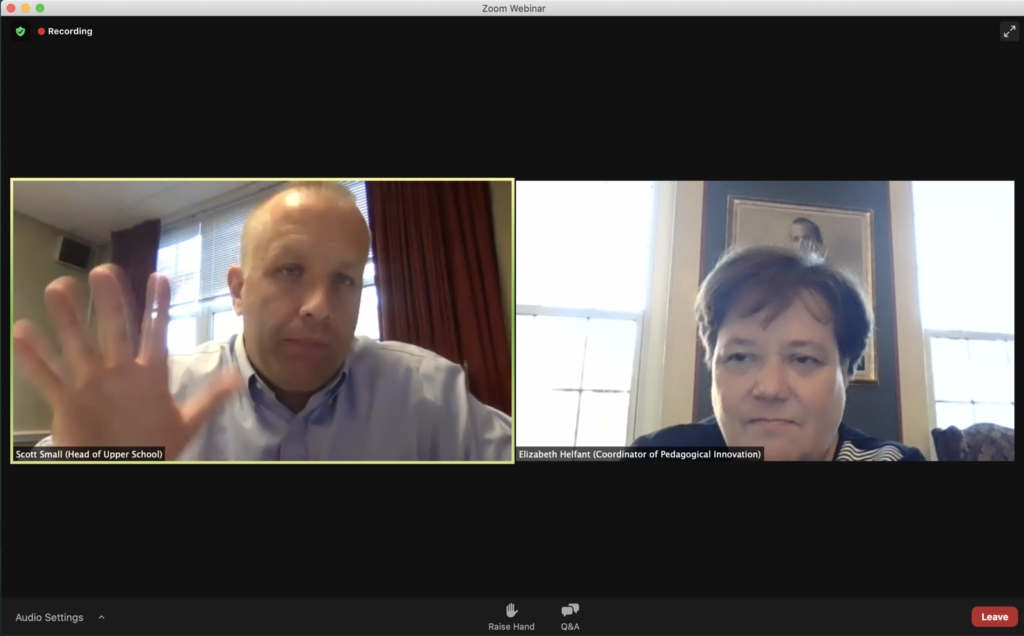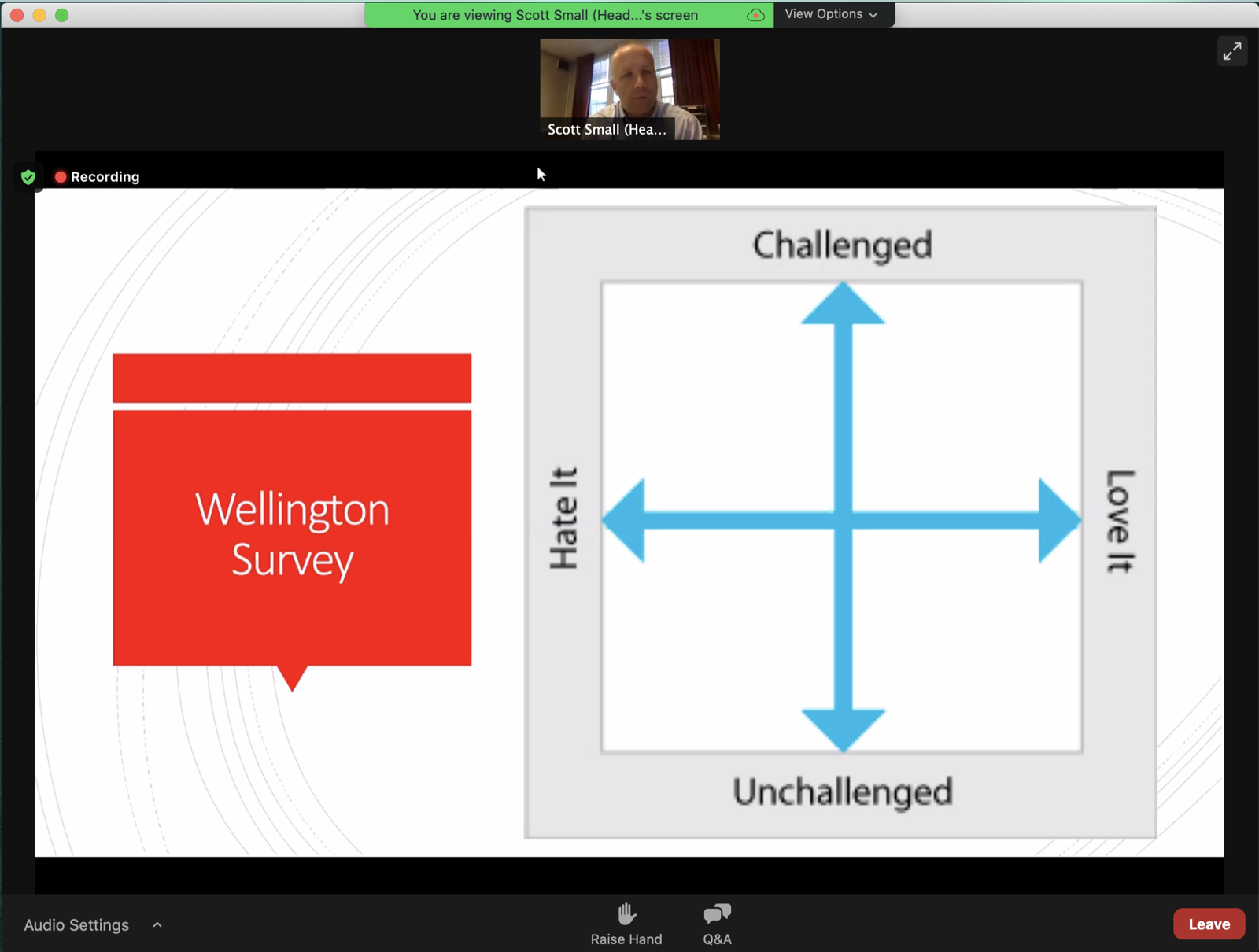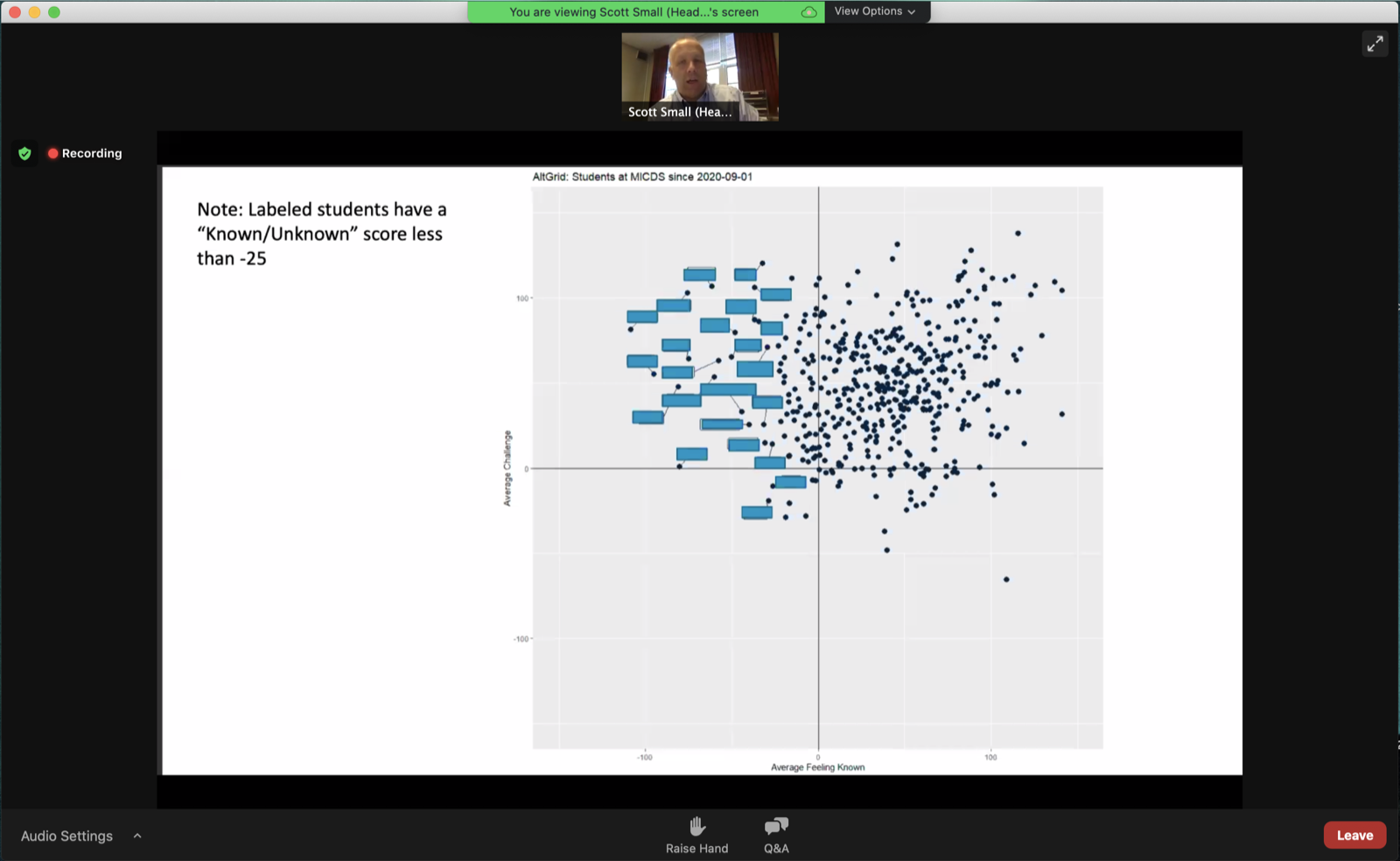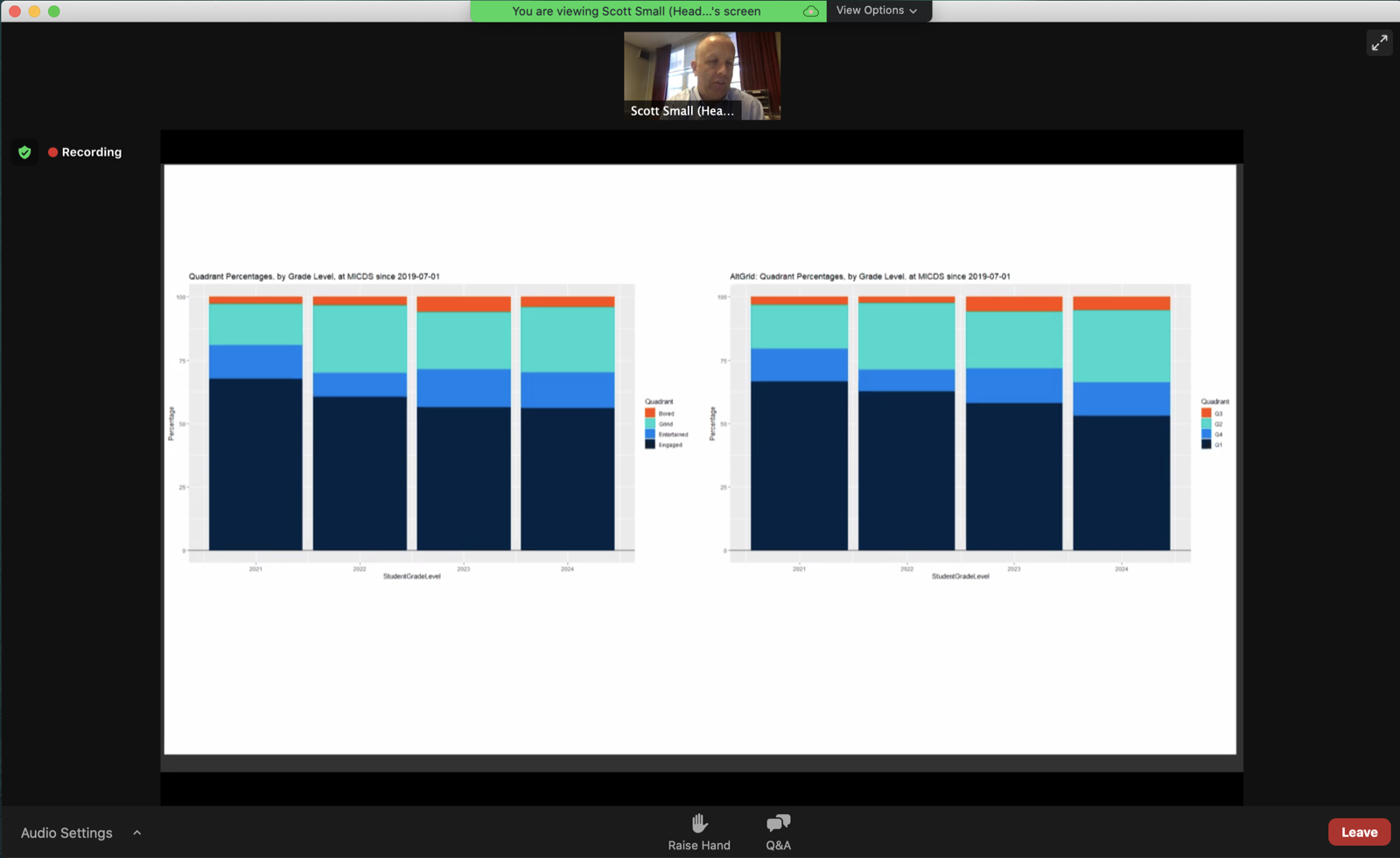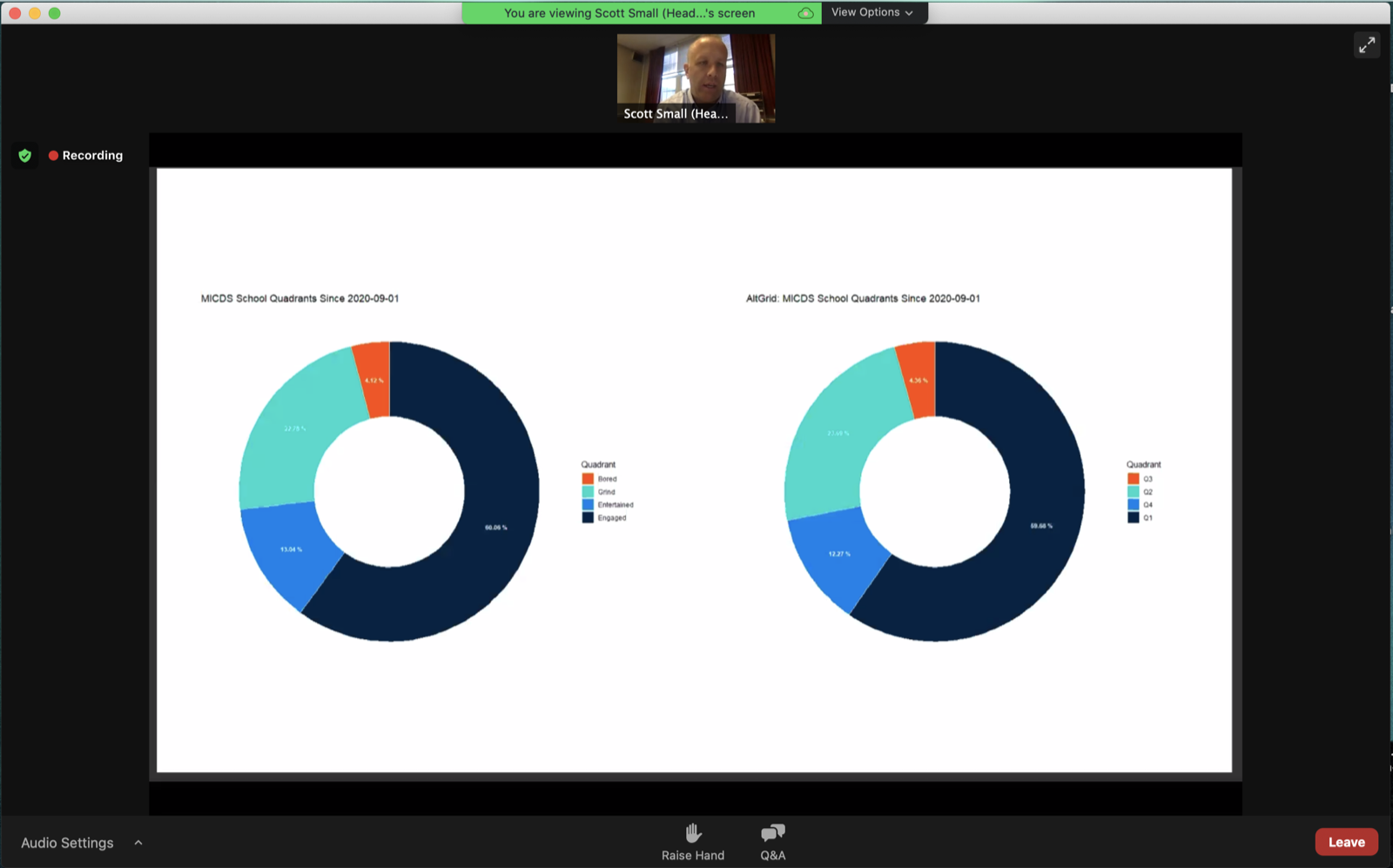Head of the Upper School Scott Small welcomed parents this week to another Sessions with Small, his regular, informal gatherings where parents can hear directly how things are going at the Upper School and ask questions. He expressed appreciation for everyone’s flexibilty to reschedule the coffee; the original date falling on what he said felt like another first day of school as we welcomed students back to campus for the resumption of in-person learning. He was grateful for the opportunity to be outside to greet students as they arrived.
Small also introduced Elizabeth Helfant, Coordinator of Pedagogical and Curricular Innovation, to the webinar, who was dialing in from a different space on campus, and who has been incredibly helpful in our collective work to transition to in-person learning in our new environment. Small and Helfant estimate they have spent over 100 hours on webinars with schools across the country, learning about various ways to get kids back on campus and doing it safely.
Since in-person learning just resumed, Small spoke about how MICDS arrived at the decision to implement our grade-level hybrid model. “As we think about hybrid models, I’ve been increasingly frustrated with nomenclature in schools. There are so many different variations of what online learning looks like, so what your kids are experiencing is very different than other schools,” he said. He explained that we arrived at our current model to avoid losing student-teacher connections while learning online, and limit degradations as much as possible. We’re also striving to limit what has been termed “academic slide,” instead, we are focused on maintaining a robust academic program.
“The best model we have is in-person learning,” Small said. “It’s the strongest framework we have to influence learning.” At the same time, having everyone online has also been a really strong framework for us due to our ability to implement synchronous learning, class schedules, and unfettered access to teachers and the opportunity to be with each other without masks on (albeit online). “It’s really important that we maintain that piece,” he said, both to benefit our students who are choosing to continue distance learning and as we work to proactively anticipate the strongest teaching models possible given whatever directions the pandemic may dictate.

He also spoke about the considerations of how to divide the student body to ensure appropriate social distancing measures. While an alphabetical model, in theory, cuts the population in half, we found anomalies in that framework. While it mitigated the risk in some classes, other rotations showed two students in one class and 12 in another. By segmenting our student population by grade, we are able to use our larger classrooms, such as the STEM building’s “c-labs,” or classroom-laboratories. This benefits the majority of students who prefer to learn on campus with their teachers. Another strength of the grade-level structure is to minimize the hybrid teaching model, which is difficult on both students and teachers.
Small explained that as members of the National Association of Independent Schools (NAIS), we are able to see school trends across the country and use them to benchmark our own efforts. « We have a slightly higher percentage of our Upper School students choosing to continue distance learning, » he said, « which I think is due in large part to the flexibility that we have intentionally built into the decision for families (in terms of not asking anyone to lock in for any set period of time in advance). »
Upper School teachers and administrators are also working hard to minimize any negative impact on students who choose or need to stay at home. The grade-level structure minimizes the impact on students who are at home, as every other week they are on the same platform as all their peers. The model doesn’t mitigate distance learning difficulties entirely, of course, so we continue to work on other ways to support these students. Owl cameras with good microphones allow for vibrant class discussion by all participants regardless of location, the creative use of some iPads, and conference microphones in rooms that are used only for advisory so that at-home students are fully integrated into the experience, all help keep the community united.
The two-day soft launches right before conferences allowed the School to confirm the effectiveness of plans regarding student migration around campus and lunch distribution. Small was excited to see how this week and next goes, with full weeks of students back on campus for in-person learning. “We will make adjustments both technical and pedagogical over the next few weeks,” said Small.
MICDS wants to remain as flexible as possible, allowing students to choose in-person or distance learning as needed based on individual needs and evolving situations. Small admitted that the areas we are finding most challenging include contact tracing and lunches. We’re asking kids to return to their classroom spaces during lunch, both for supervision and to maintain their cohorts for contact tracing. “We are ultimately trying to limit the need for quarantine,” Small said, “and we’re trying to keep in-person learning going.” He mentioned that this year, we are much more liberal in our allowance of 11th and 12th graders to go off-campus. “We are letting them sign out at any point in time if they have a free period. It helps keep numbers down on campus, although I don’t love it because it doesn’t help the sense of community. The safety needs to outweigh everything else, though,” he said.
Small spoke about how after safety, our biggest commitment in this framework is to maintain our academic program. “I have not seen our faculty work harder, and our faculty is already one of the hardest working faculty around,” he said. He explained how our teachers are now in their third iteration of what school looks like in six months, and shared that master teachers with 20-30 years of experience feel like they are first-year teachers again. Ever the optimist, Small said that he views the changes as refreshing, and that an opportunity to force us all to rethink our practices is not a bad thing. “It’s a lot of work, but it’s not a bad thing.”
Helfant shared how she’s done work around helping faculty learn new ways of assessing student learning. When we don’t have have a traditional framework of students taking tests and quizzes right in front of their teachers, how can we reframe our assessment practices to still provide effective feedback about student progress without questioning academic integrity? “The hallmark of our school is our honor system,” she said, “and we are asking them to not put themselves in a position where they could be tempted.”
Small and Helfant also spoke about how the hybrid classroom makes full class discussions more challenging. “You’re seeing more of an old-school teaching approach, so it’s more teacher-focused than we’d like them to be,” explained Small. “We prefer student-centered learning but that’s the technology presents a challenge there.” Much of the sponenteity and vibrance of an in-person group discussion is limited by software that dampens the easy flow of conversation.
Parents were also introduced (or re-introduced) to the Wellington Survey, a simple but elegant grid format that allows students to rank how they’re feeling about their classes on two axes: Hate It to Love It, and Challenging to Unchallenging. “We want to see kids in the upper righthand quadrant, where they Love It and they feel Challenged,” Small explained. “That’s an engaged quadrant.” Love It but Unchallenged is what we call the “entertained” quadrant, and we often see art classes slide below the Challenge line and stay on the Love It side, but that’s okay. We don’t want to see the upper left quadrant, or what we call the “grind” quadrant. Finally, the lower left section is termed the “bored” quadrant, where students say, “I don’t like this class and I’m not challenged.” We work hard to get classes out of that quadrant if we get feedback like that.
The Wellington School developed this survey on its own, and Helfant has worked with their administrators to create a second axis, replacing Love It to Hate It with I Feel Known and I Don’t Feel Know. It’s important to us that each of our students feels seen and known, so we want to capture that data and learn how we can keep improving. Small explained that our Wellington data hasn’t changed significantly since the transition to distance learning and now our hybrid model, and our numbers tend to consistently run higher than what Wellington is seeing from schools across the country. Small is heartened by witnessing that connections and learning are still happening unfettered by our restrictions. He worries that kids who haven’t been to campus may not feel seen and known, but said that when they are in their own space they don’t have to wear masks, so everyone can see their whole faces. “Masks are a challenge we have to overcome on campus,” he said.
The Wellington data also shows administrators the students’ names for those who fall into the most “at risk” category. “We are able to frame our interventions with kids, whether it’s academic or a student support group with a counselor, a learning specialist, or nurse, and find the best solution for them.” He defines “at risk” as those students for whom school is not working the way we want it to. He mentioned again that it’s important for students to have one teacher and one peer who they can turn to and rely on. Thanks to Wellington, we can use this data early, not waiting for grades to drop, or another indicator to surface. “This early intervention tool is really helpful for us,” said Small.
Small gave some important upcoming dates, and explained the reason why Head of School Jay Rainey elected to give the entire week of Thanksgiving off for students and teachers. “He recognizes how challenging online learning is for our students and teachers, and this chance to get some time off serves them both well for their overall wellbeing. It’s also an opportunity for our teachers to regroup.”
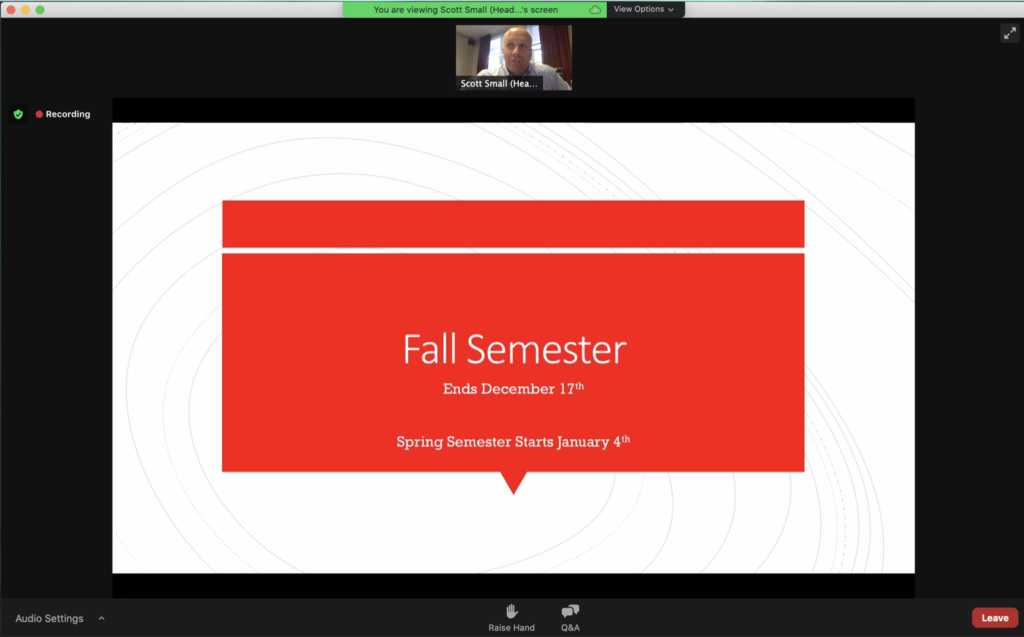
He also spoke about our new Winter Term being delayed by a year for a variety of reasons. Instead we will start our second semester on January 4 and have a semester that is a couple of weeks longer this year. It’s beneficial for our students to have more prep time for AP exams, and for curriculum retention in general given our new model. “It will be great to have Winter Term in the future for internship and travel opportunities, but they’re so unlikely to happen this year due to the pandemic that we’ll reclaim those two weeks,” he said.
He reiterated that safety was paramount as to why we didn’t go to in-person learning earlier, in addition to wanting to ensure our academic program didn’t slip for students. “We’ve worked to find balance, to maintain academic robustness, academic trajectory, and intellectual engagement, and to promote social-emotional wellness. Trying to find that balance has driven our decision making to this point,” he said.
As he wrapped up the session, Small also fielded several compliments from parents, expressing gratitude and saying, “We have made mistakes and we’ll continue to make them but I am extraordinarily proud of our community.” He credited compliments as testaments to the work our faculty is doing to ensure all of our students are served, and he gave credit to the resilience of MICDS students. “Our kids have been remarkable and patient. They know what is asked of them and why, and they are committed to it. This is a remarkable community, and I am thankful for the partnership with our families that enables this.”
